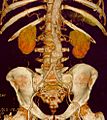Aortic aneurysm facts for kids
An aortic aneurysm is a serious condition where a part of your aorta gets bigger than it should. Think of it like a ballooning or bulge in this very important blood vessel. The aorta is the largest artery in your body. It carries oxygen-rich blood from your heart to the rest of your body. When a part of the aorta bulges out, its wall becomes weak.
Sometimes, an aneurysm might cause pain. This pain can be a warning sign that the bulge might break open. If it breaks, a lot of internal bleeding can happen very quickly. This is a medical emergency and needs immediate treatment to save a person's life.
Contents
Understanding Aortic Aneurysms
What is the Aorta?
The aorta is like the main highway for blood leaving your heart. It starts at the top of your heart and goes down through your chest and belly. Smaller blood vessels branch off from it to deliver blood everywhere else. Because it's so important, any problem with the aorta can be very serious.
What is an Aneurysm?
An aneurysm happens when a section of the aorta's wall weakens and stretches out. This makes a bulge or balloon-like shape. If this bulge gets too big, it can put a lot of pressure on nearby organs. The biggest danger is that the weakened wall could tear or burst.
Where Aneurysms Happen
Aortic aneurysms can form in different parts of the aorta.
- Abdominal Aortic Aneurysm (AAA): This is the most common type. It happens in the part of the aorta that goes through your belly.
- Thoracic Aortic Aneurysm (TAA): This type forms in the part of the aorta that runs through your chest.
What Causes an Aortic Aneurysm?
Sometimes, the exact reason for an aneurysm isn't known. However, several things can make someone more likely to develop one. These are called risk factors.
Common Risk Factors
- High Blood Pressure: If your blood pressure is too high for a long time, it can put extra stress on your artery walls, making them weaker.
- Smoking: Chemicals in tobacco smoke can damage blood vessels and make them stiff and weak.
- Atherosclerosis: This is when plaque (a sticky substance) builds up inside your arteries. It can make them narrow and stiff, and also weaken their walls.
- Age: Aneurysms are more common in older people, usually over 65.
- Family History: If someone in your family has had an aortic aneurysm, you might be more likely to get one too.
- Certain Medical Conditions: Some diseases, like Marfan syndrome or Ehlers-Danlos syndrome, can weaken the body's connective tissues, including those in the aorta.
Symptoms and Diagnosis
Many aortic aneurysms don't cause any symptoms, especially when they are small. This is why they are often found by accident during tests for other health issues.
When Symptoms Appear
If an aneurysm grows larger or starts to leak, you might notice some signs:
- Pain: This can be a deep, constant pain in your belly, chest, or back. The pain might spread to your groin or legs.
- Pulsating Feeling: You might feel a throbbing or pulsing sensation in your belly, similar to a heartbeat.
- Hoarseness or Trouble Swallowing: If a thoracic aneurysm presses on your windpipe or food pipe, it can cause these problems.
How Doctors Find Aneurysms
Doctors use different tests to find and check on aneurysms:
- Ultrasound: This uses sound waves to create pictures of your aorta. It's often used to screen for aneurysms, especially in older men who smoke.
- CT Scan (Computed Tomography): This uses X-rays and a computer to make detailed cross-sectional images of your body. It gives a very clear picture of the aneurysm's size and shape.
- MRI (Magnetic Resonance Imaging): This uses powerful magnets and radio waves to create detailed images. It's another way to get clear pictures of the aorta.
Treatment for Aortic Aneurysms
The treatment for an aortic aneurysm depends on its size, how fast it's growing, and your overall health.
Watchful Waiting
If an aneurysm is small and not causing symptoms, doctors might suggest "watchful waiting." This means they will regularly check the aneurysm with imaging tests (like ultrasound or CT scans) to see if it's growing. You might also be given medicines to help control blood pressure or cholesterol.
Surgery
If an aneurysm is large, growing quickly, or causing symptoms, surgery might be needed to fix it. The goal of surgery is to prevent the aneurysm from bursting.
Types of Surgery
- Open Repair: This is a major surgery where a surgeon makes a cut in your belly or chest to reach the aorta. The weakened part of the aorta is removed and replaced with a strong, artificial tube called a graft.
- Endovascular Aneurysm Repair (EVAR): This is a less invasive procedure. The surgeon inserts a thin tube (catheter) into an artery in your leg. Through this tube, a special fabric-covered metal stent-graft is guided to the aneurysm. The stent-graft expands inside the aorta, reinforcing the weakened wall and allowing blood to flow through it without pushing on the aneurysm.
Living with an Aortic Aneurysm
Even after treatment, it's important to live a healthy lifestyle to protect your heart and blood vessels.
Healthy Habits
- Don't Smoke: If you smoke, quitting is one of the best things you can do for your health.
- Control Blood Pressure: Take any prescribed medicines and follow your doctor's advice to keep your blood pressure at a healthy level.
- Eat Healthy: A balanced diet with lots of fruits, vegetables, and whole grains can help your heart.
- Stay Active: Regular exercise, as advised by your doctor, can strengthen your heart and blood vessels.
- Regular Check-ups: Keep up with your doctor's appointments and follow-up tests.
Images for kids
-
CT reconstruction image of an abdominal aortic aneurysm
See also
 In Spanish: Aneurisma de aorta para niños
In Spanish: Aneurisma de aorta para niños





